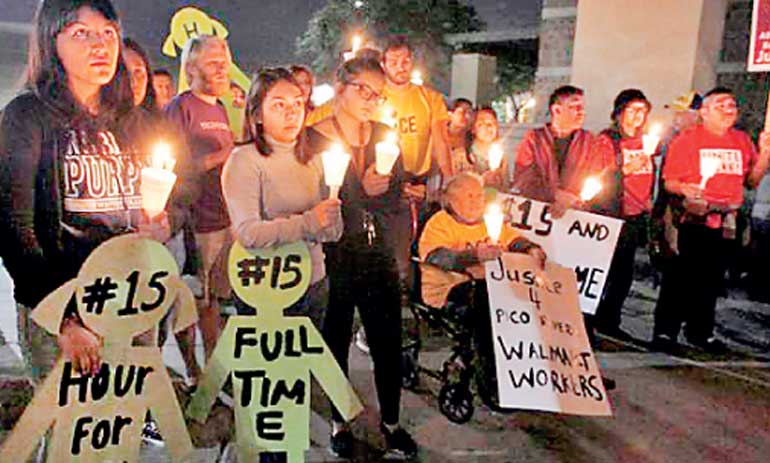Thursday Feb 13, 2025
Thursday Feb 13, 2025
Tuesday, 5 January 2016 00:01 - - {{hitsCtrl.values.hits}}
Reuters: As the United States marks more than six years without an increase in the federal minimum wage of $ 7.25 an hour, 14 states and several cities are moving forward with their own increases, with most set to start taking effect on Friday.
California and Massachusetts are highest among the states, both increasing from $ 9 to $ 10 an hour, according to an analysis by the National Conference of State Legislatures. At the low end is Arkansas, where the minimum wage is increasing from $ 7.50 to $ 8. The smallest increase, a nickel, comes in South Dakota, where the hourly minimum is now $ 8.55.
The increases come in the wake of a series of ‘living wage’ protests across the country, including a November campaign in which thousands of protesters in 270 cities marched in support of a $ 15-an-hour minimum wage and union rights for fast food workers. Food service workers make up the largest group of minimum-wage earners, according to the Bureau of Labor Statistics.

Protesters outside Walmart hold a candle light vigil after a march for a $15 per hour minimum wage and the reinstatement of employees who lost their jobs, ahead of Black Friday in Pico Rivera, California – REUTERS
With Friday’s increases, the new average minimum wage across the 14 affected states rises from $ 8.50 an hour to just over $ 9.
Several cities are going even higher. Seattle is setting a sliding hourly minimum between $ 10.50 and $ 13 on 1 January, and Los Angeles and San Francisco are enacting similar increases in July, en route to $ 15 an hour phased in over six years.
Backers say a higher minimum wage helps combat poverty, but opponents worry about the potential impact on employment and company profits.
In 2014, a Democratic-backed congressional proposal to increase the federal minimum wage for the first time since 2009 to $ 10.10 stalled, as have subsequent efforts by President Barack Obama. More recent proposals by some lawmakers call for a federal minimum wage of up to $ 15 an hour.
Alan Krueger, an economics professor at Princeton University and former chairman of Obama’s Council of Economic Advisers, said a federal minimum wage of up to $ 12 an hour, phased in over five years or so, “would not have a noticeable effect on employment.”
Some employers may cut jobs in response to a minimum-wage increase, Krueger said, while others may find hikes allow them to fill job vacancies and reduce turnover, lifting employment but lowering profits.
In recent years, an increasing number of states and municipalities have enacted their own wage floor policies. Currently, 29 states plus the District of Columbia and about two dozen cities and counties have their minimum wage at levels higher than the federal minimum.
Many are now in the midst of multi-year phase-in plans that will ultimately take them to between $ 10 and $ 15 an hour.
The 14 states where increases take effect on Friday are: Alaska, Arkansas, California, Colorado, Connecticut, Hawaii, Massachusetts, Michigan, Nebraska, New York, Rhode Island, South Dakota, Vermont and West Virginia.
The non-partisan Congressional Budget Office estimated 2014 federal proposal would have raised the wages of 16.5 million Americans and lifted 900,000 of them out of poverty but would have cost as many as 1 million jobs.
Discover Kapruka, the leading online shopping platform in Sri Lanka, where you can conveniently send Gifts and Flowers to your loved ones for any event including Valentine ’s Day. Explore a wide range of popular Shopping Categories on Kapruka, including Toys, Groceries, Electronics, Birthday Cakes, Fruits, Chocolates, Flower Bouquets, Clothing, Watches, Lingerie, Gift Sets and Jewellery. Also if you’re interested in selling with Kapruka, Partner Central by Kapruka is the best solution to start with. Moreover, through Kapruka Global Shop, you can also enjoy the convenience of purchasing products from renowned platforms like Amazon and eBay and have them delivered to Sri Lanka.
Discover Kapruka, the leading online shopping platform in Sri Lanka, where you can conveniently send Gifts and Flowers to your loved ones for any event including Valentine ’s Day. Explore a wide range of popular Shopping Categories on Kapruka, including Toys, Groceries, Electronics, Birthday Cakes, Fruits, Chocolates, Flower Bouquets, Clothing, Watches, Lingerie, Gift Sets and Jewellery. Also if you’re interested in selling with Kapruka, Partner Central by Kapruka is the best solution to start with. Moreover, through Kapruka Global Shop, you can also enjoy the convenience of purchasing products from renowned platforms like Amazon and eBay and have them delivered to Sri Lanka.